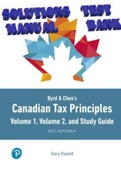Exam (elaborations)
Byrd & Chen's Canadian Tax Principles, 1st Edition. Volume 1, Volume 2 by Clarence Byrd, Ida Chen | All Chapters. SOLUTIONS MANUAL & TEST BANK
- Course
- Canadian Tax Principles
- Institution
- Canadian Tax Principles
Byrd & Chen's Canadian Tax Principles, , 1st edition. Volume 1, Volume 2 by Clarence Byrd, Ida Chen. ISBN-13: 6527. All Chapters. (Complete) Solutions Manual & TEST BANK TABLE OF CONTENT 1 Introduction to Federal Taxation in Canada 2 Procedures and Administration 3 Income or Loss from an Office or...
[Show more]




